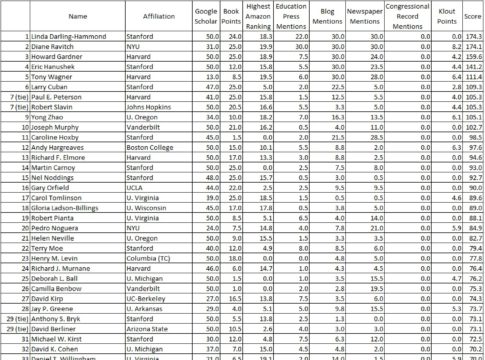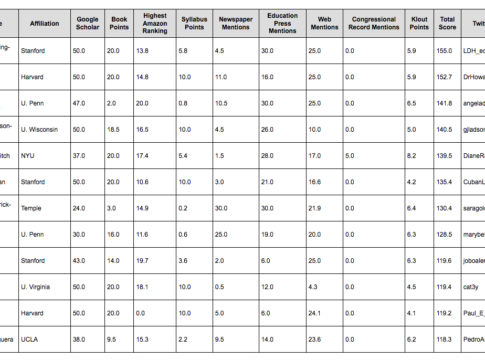Each year, on his blog Rick Hess Straight Up, EdNext executive editor and AEI scholar Rick Hess honors and ranks the 200 education scholars who had the biggest influence on the nation’s education discourse. Click here for an explanation of the purpose of the rankings.
Below are the 2016 RHSU Edu-Scholar Public Influence Rankings. Simply being included in this list of 200 scholars is an honor, given the tens of thousands who might qualify. The ranked scholars include the top 150 finishers from last year, along with 50 “at-large” nominees chosen by the 26-member selection committee (see this post for a list of committee members and all other requisite details). The metrics, as explained here, recognize university-based scholars in the U.S. who are doing the most to influence educational policy and practice. The rubric reflects both a scholar’s larger body of work and their impact on the public discourse last year.
Here are the 2016 rankings (click chart for larger view). Please note that all university affiliations reflect a scholar’s institution as of December 2015.
Only university-based researchers are eligible for the rankings. (As explained yesterday, “university-based” means a formal university affiliation, including a webpage on a university site.) After all, the point is to encourage universities to pay more attention to the stuff of scholarly participation in the public square. The term “university-based” provides some useful flexibility. For instance, Margaret “Macke” Raymond runs the evaluation outfit CREDO. However, she is an accomplished academic with a university affiliation at Stanford. So she’s included. The line is admittedly blurry, but it seems to work reasonably well. The bottom line is that this is a serious but inevitably imperfect attempt to nudge universities, foundations, and professional associations to do more to cultivate, encourage, and recognize contributions to the public debate.
Without further ado, let’s get to the results. The top scorers? All are familiar edu-names, with long careers featuring influential scholarship, track records of comment on public developments, and outsized public and professional roles. In order, the top five were Linda Darling-Hammond of Stanford, Diane Ravitch of NYU, Howard Gardner of Harvard, UCLA’s Gary Orfield, and U. Wisconsin’s Gloria Ladson-Billings. Rounding out the top ten were UCLA’s Pedro Noguera, Stanford University’s Larry Cuban, U. Oregon’s Yong Zhao, Claude Steele of UC Berkeley, and Andy Hargreaves of Boston College. All ten are veteran, accomplished scholars who have each authored a number of (frequently influential) books, accumulated bodies of heavily cited scholarly work, and are often seen in the public square and working with state and district leaders. That reflects the intent of the rankings, which weight the broad, lasting public influence of a scholar at least as heavily as a short run of high visibility.
Stanford’s Macke Raymond made the biggest single leap from last year, climbing 81 spots. Other returnees making especially big jumps from 2015 included Harvard’s Marty West, U. Michigan’s Nell Duke, Christopher Lubienski of U. Illinois, Dan Goldhaber of U. Washington, Columbia’s Jeff Henig, and Tulane’s Doug Harris.
Stanford University, U. Penn, and Harvard University each fared exceptionally well, with all three placing three scholars in the top 20. UCLA, U. Wisconsin, and U. Virginia also placed multiple scholars in the top 20. In terms of the institutions that had the most scholars make the list, Harvard led the pack with 21. Stanford was second, with 20, and Columbia was third, with 14. Overall, more than 50 universities had at least one scholar make the cut.
A number of top scorers penned influential books of recent vintage. For instance, just in the past year, Harvard’s Tony Wagner coauthored Most Likely to Succeed: Preparing Our Kids for the Innovation Era; Richard Milner of U. Pittsburgh authored Rac(e)ing to Class: Confronting Poverty and Race in Schools and Classrooms; and Columbia University’s Tom Bailey copublished Redesigning America’s Community Colleges: A Clearer Path to Student Success.
As with any such ranking, this exercise ought to be interpreted with appropriate caveats and caution. Given that the ratings are a snapshot of where things stand as we start 2016, the results obviously favor scholars who penned a successful book or influential study in 2015. But that’s how the world works. And that’s why we do this every year.
A few scholars tended to lead the field in any given category. For those keeping score at home, here’s a quick review of the category-killers:
More than thirty scholars maxed out on Google Scholar. When it came to book points, ten scholars maxed out, including Darling-Hammond, Ravitch, Gardner, Cuban, and Paul Peterson of Harvard. Wagner and Steele took top honors for Amazon points, with 19.4 apiece. As far as attention in the education press, Darling-Hammond, Ravitch, Noguera, U. Wisconsin’s Sara Goldrick-Rab, and Angela Duckworth of U. Penn were the leaders.
When it came to mentions in mainstream newspapers, Orfield, Goldrick-Rab, U. Penn’s Richard Ingersoll, and Jonathan Zimmerman of NYU topped the charts. In terms of web visibility, Darling-Hammond, Ravitch, Gardner, Noguera, Goldrick-Rab, Duckworth, Michigan State’s Bill Schmidt, and Marc Lamont Hill of Morehouse College were tops. In the wild-and-woolly world of Klout scores, Ravitch and Lamont Hill dominated.
If readers want to argue the relevance, construction, reliability, or validity of the metrics, go for it. I’m not sure that I’ve got the measures right or even how much these results can or should tell us. That said, I think the same can be said about U.S. News college rankings, NFL quarterback ratings, or international scorecards of human rights. For all their imperfections, I think such efforts convey real information—and help spark useful discussion.
That’s what I’ve sought to do here. Meanwhile, I’d welcome suggestions for possible improvements and am eager to hear your thoughts, critiques, questions, and suggestions. So, take a look, and have at it.
—Rick Hess
This post originally appeared on Rick Hess Straight Up. Readers who are curious as to how scholars fared when it came to particular fields or disciplines should click here to see the top ten finishers for five disciplinary categories, as well as the top ten junior faculty.





